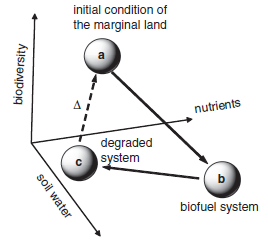Bioeconomic sustainability of cellulosic biofuel production
The use of marginal land (ML) for lignocellulosic biofuel production is examined for system stability, resilience, and eco-social sustainability. A North American prairie grass system and its industrialization for maximum biomass production using biotechnology and agro-technical inputs is the focus of the analysis. Demographic models of ML biomass production and ethanol farmer/producers are used to examine the stability properties of the ML system. A bio-economic model that maximizes the utility of consumption having the dynamics of MLs and the farmer/producers as dynamic constraints is used to examine the effects of increased conversion efficiency, input costs, risk, and levels of base resources and inputs on the competitive and societal solutions for biomass production. We posit ML abandonment after biofuel production ceases could lead to permanent land degradation below initial levels that prohibit the establishment of the original flora and fauna.
Gutierrez A.P., Ponti L., 2009. Bio-economic sustainability of cellulosic biofuel production on marginal lands. Bulletin of Science Technology and Society, 29: 213-225.
http://dx.doi.org/10.1177/0270467609333729
Gutierrez A.P., Ponti L., 2009. Bio-economic sustainability of cellulosic biofuel production on marginal lands. Bulletin of Science Technology and Society, 29: 213-225.
http://dx.doi.org/10.1177/0270467609333729


Comments
Post a Comment